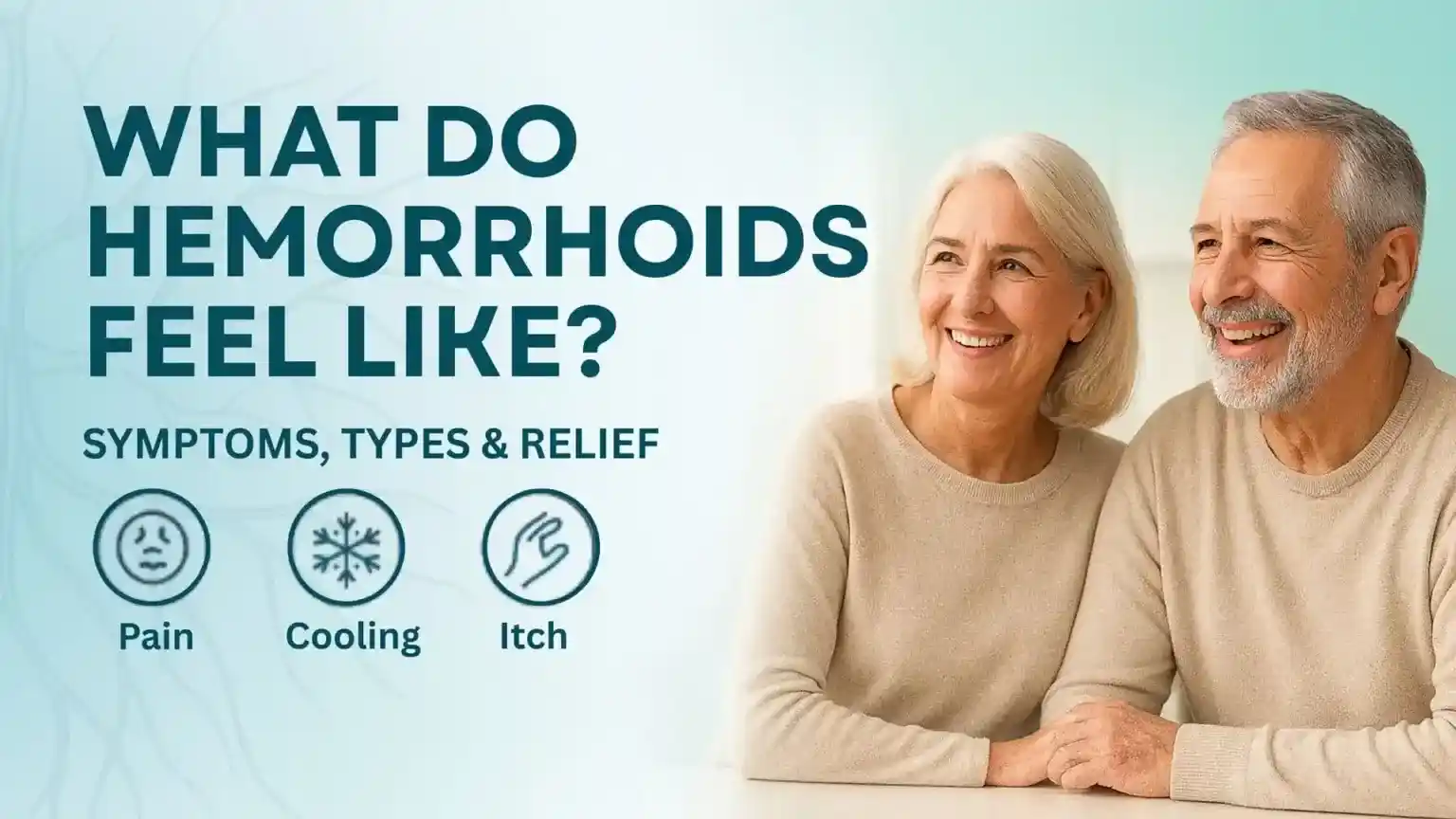A Quick Medical Overview: Hemorrhoids, often called piles, are swollen veins located in the lower part of the rectum and anus.
Think of them like varicose veins — but in a far more sensitive place. They’re extremely common, affecting nearly 1 in 2 people over the age of 50, according to data from the American Society of Colon and Rectal Surgeons (ASCRS, 2023).
At their core, hemorrhoids develop when the veins in the rectal area become inflamed or stretched due to increased pressure.
This pressure can come from various lifestyle or medical causes, which we’ll explore in a moment.
Table of Contents
ToggleWhy Do Hemorrhoids Happen? (The Science Behind the Swell)
The walls of these rectal veins are very thin. When strained, the veins swell and bulge, resulting in either internal hemorrhoids (inside the rectum) or external hemorrhoids (under the skin around the anus).
Key factors contributing to hemorrhoid development:
- Chronic constipation or straining during bowel movements
- Sitting on the toilet for long periods
- Pregnancy (due to increased abdominal pressure)
- Obesity and sedentary lifestyle
- Low-fiber diets
- Aging (weakened vein elasticity)
According to a 2022 study published in the Journal of Gastrointestinal and Liver Diseases, patients who consumed less than 15g of fiber per day had a 2.4x higher risk of developing symptomatic hemorrhoids.
Types of Hemorrhoids (Classified by Location)
| Type | Location | Typical Symptoms |
|---|---|---|
| Internal Hemorrhoids | Inside the rectum | Usually painless; may bleed during bowel movements |
| External Hemorrhoids | Around the anal opening | Painful, itchy, can feel like lumps |
| Thrombosed Hemorrhoids | External hemorrhoids with a blood clot | Severe pain, swelling, and bluish discoloration |
Is It Dangerous?
Hemorrhoids themselves aren’t life-threatening, but they can cause significant discomfort and disrupt daily life. However, rectal bleeding — a common symptom — should never be ignored.
It could signal something more serious, such as a fissure, infection, or colorectal cancer.
That’s why understanding the exact sensation of hemorrhoids, how they evolve, and what warning signs to watch for is crucial, which is exactly what the next part of this blog will uncover.
What Do Hemorrhoids Feel Like?
Hemorrhoids can feel different depending on their type, size, and stage — but most people describe them as a mix of pain, pressure, itching, and irritation near the anus or inside the rectum.
Early Signs: Mild but Noticeable Discomfort
In the beginning, hemorrhoids may feel like:
- A mild itch around the anus
- A burning sensation after a bowel movement
- Moisture or mucus leakage in your underwear
- A feeling like you didn’t fully empty your bowels
Often, these symptoms are intermittent — they come and go. That’s why many people dismiss early hemorrhoids as a hygiene issue or a result of spicy food.
Pain or Just Pressure? The Sensory Difference
Here’s how to tell what type of discomfort you’re feeling:
External hemorrhoids: Usually painful to the touch, especially during wiping. Sitting may worsen the pain.
Internal hemorrhoids: Generally painless but can cause a dull pressure sensation inside the rectum.
Thrombosed hemorrhoids (a clot inside a vein): Sudden, sharp pain, bluish swelling, and inflammation.
According to a 2023 update by Cleveland Clinic, thrombosed external hemorrhoids can cause “intense rectal pain, making it difficult to sit, walk, or pass stool.
How Hemorrhoids Feel Based on Type
| Hemorrhoid Type | Feels Like |
|---|---|
| Internal (mild) | Fullness, pressure, or no feeling at all |
| Internal (bleeding) | No pain, but blood on the toilet paper |
| External (non-thrombosed) | Itchy, burning bump near the anus |
| External (thrombosed) | Sharp, sudden pain, hard purple lump |
| Healing hemorrhoid | Sensitive skin, light itch during cleansing |
How Hemorrhoid Pain Can Disrupt Daily Life
Unmanaged hemorrhoids can:
Causes sharp, shooting pain while sitting
Make bowel movements dreadful and painful
Trigger constant itchiness or a wet, irritated feeling
Affect your confidence and comfort in public settings
In short, they’re not just a bathroom issue. They can interrupt sleep, focus, travel plans, and even sexual intimacy due to discomfort.
Hemorrhoids vs Other Rectal Conditions
Sometimes people think they have hemorrhoids when it’s actually something else:
| Condition | How It Feels |
|---|---|
| Anal fissure | Sharp pain and bleeding during bowel movement |
| Rectal abscess | Throbbing pain, fever, swelling |
| Colorectal cancer | Painless bleeding, changes in stool shape |
If your hemorrhoids are external and painful, a combination of cold compress and a topical ointment can ease the inflammation quickly. But if you feel pressure without pain, you may be dealing with internal hemorrhoids, and fiber might be your best medicine. If the sensation is unusual, worsening, or accompanied by other symptoms like fever or weight loss, don’t self-diagnose. It’s always safer to consult a doctor or pharmacist.
Internal vs External Hemorrhoids: How Do They Differ?
Understanding the location and behavior of hemorrhoids is key to recognizing symptoms and choosing the right treatment.
Internal and external hemorrhoids don’t just differ in where they form — they also feel very different, react differently to pressure, and require different care strategies.
Where They Form
Internal Hemorrhoids – Inside the rectum, above the dentate (anal) line
External Hemorrhoids – Beneath the skin around the anal opening, below the dentate line
The dentate line is the anatomical divide between pain-sensitive and pain-insensitive areas — which is why internal hemorrhoids are often painless.
Symptoms Comparison: What You’ll Likely Experience
| Symptom | Internal Hemorrhoids | External Hemorrhoids |
|---|---|---|
| Pain | Rare unless prolapsed | Common; can be sharp or dull |
| Bleeding | Bright red blood on stool | Less frequent, but possible |
| Swelling/Lump | Rarely felt | Common, especially if thrombosed |
| Itching/Burning | May occur if prolapsed | Frequent and irritating |
| Pressure or Fullness | Common | Less common |
| Mucus Discharge | Occasionally | Rare |
Thrombosed Hemorrhoids: A Painful Twist
A thrombosed external hemorrhoid occurs when a blood clot forms inside the swollen vein. This causes:
- Sudden, intense pain
- A hard, bluish lump near the anal opening
- Swelling and inflammation
In contrast, internal hemorrhoids can prolapse — meaning they slip out of the anus — causing discomfort, mucus, and sometimes bleeding. While not usually painful, prolapsed hemorrhoids can become irritated and harder to manage without treatment.
How to Tell What You Have — Quick Self-Check (Not a Diagnosis)
Do you feel a lump or sharp pain near your anus, especially when sitting? → Likely external
Is there no visible lump but bright red blood after wiping? → Possibly internal
Does the discomfort worsen with straining or long sitting sessions? → Could be either
Note: Self-diagnosis isn’t foolproof. If symptoms persist, escalate, or become confusing — consult a doctor or pharmacist.
Treatment Paths Vary by Type
Internal Hemorrhoid Relief:
- High-fiber diet and hydration
- OTC suppositories and stool softeners
- Medical procedures like rubber band ligation
External Hemorrhoid Relief:
Sitz baths
Topical ointments (e.g., hydrocortisone)
Common Symptoms of Hemorrhoids
Hemorrhoids can show up in surprisingly different ways depending on their type, stage, and severity.
For some people, it starts with mild itching. For others, it may involve noticeable bleeding or even a painful lump that makes sitting unbearable.
Understanding these core symptoms can help you catch hemorrhoids early and treat them before they worsen.
Top 7 Most Reported Hemorrhoid Symptoms
- Rectal bleeding (bright red blood)
- Itching or burning around the anus
- Pain during or after bowel movements
- Swelling or lumps near the anal area
- Mucus discharge or a wet sensation
- A feeling of incomplete evacuation
- Tenderness or discomfort while sitting
According to a 2023 study published in the Journal of Colorectal Surgery, rectal bleeding was the most common presenting symptom in over 63% of hemorrhoid cases.
Is Rectal Bleeding Always a Sign of Hemorrhoids?
Not necessarily. While bright red bleeding during wiping is a classic symptom of internal hemorrhoids, other conditions can also be responsible:
Possible rectal bleeding causes:
- Anal fissures – sharp tearing pain with blood
- Colon polyps or colorectal cancer – often painless but recurring bleeding
- Inflammatory bowel disease (IBD) – includes mucus, diarrhea, abdominal cramps
- Infections or STIs – especially if accompanied by discharge or fever
How to Relieve Hemorrhoid Pain at Home
Whether you’re dealing with a dull ache or a sharp sting, the good news is that most hemorrhoids can be managed at home with consistent care and the right tools.
Let’s explore trusted, evidence-based remedies that actually work — no gimmicks, no fluff.
1. Sitz Baths (Warm Water Soak)
One of the simplest and most effective methods. Soak your bottom in warm (not hot) water for 15–20 minutes, 2–3 times a day — especially after a bowel movement.
Why it works:
- Reduces inflammation
- Relaxes the sphincter muscle
- Provides near-instant soothing relief
Use a sitz bath kit like this one for safe, mess-free soaking.
2. Cold Compress for Swelling and Pain
Applying an ice pack (wrapped in a clean cloth) to the area for 10–15 minutes can numb pain and reduce swelling, especially with external hemorrhoids or thrombosed lumps.
3. Topical Ointments and Numbing Creams
Over-the-counter creams can help relieve itching, burning, and inflammation.
🧴 Explore and Try Two Well-Known Brands:
Avoid overusing steroid-based creams beyond 7 days unless directed by a doctor — they can thin the skin over time.
4. Upgrade Your Bathroom Habits
- Don’t strain or push during bowel movements
- Use unscented moist wipes instead of dry toilet paper
- Don’t sit on the toilet for too long (no scrolling!)
- Keep the area clean and dry
5. High-Fiber Diet + Hydration
A constipated colon is a hemorrhoid’s best friend. Prevent flare-ups by softening your stool.
- Add 25–30g of fiber per day from fruits, vegetables, and whole grains
- Try psyllium husk or wheat bran as fiber supplements
- Drink at least 8 glasses of water daily
According to a 2022 meta-analysis published in the American Journal of Gastroenterology, fiber intake reduces the risk of bleeding hemorrhoids by over 50% in chronic sufferers.
Don’t let discomfort disrupt your life. At Pharmacy24, you’ll find doctor-trusted relief options, discreet shipping, and compassionate support — because hemorrhoid care should never be embarrassing.
Explore our hemorrhoid relief:
Conclusion: Listen to the Signs — Your Body Knows Best
Hemorrhoids are far more common than most people realize — and while they can feel uncomfortable, embarrassing, or even frightening at first, they’re rarely dangerous when addressed early.
If you’ve been asking, “what do hemorrhoids feel like?”, now you know: the sensations range from a mild itch to sharp pain, depending on the type and severity.
Internal hemorrhoids may go unnoticed until you spot blood during wiping, while external ones often feel like painful, swollen lumps that can disrupt your daily routine.
The good news? With the right knowledge, trusted treatments, and some simple lifestyle adjustments, you can relieve hemorrhoid pain, reduce recurrence, and feel like yourself again.


